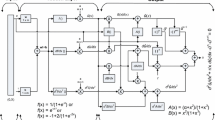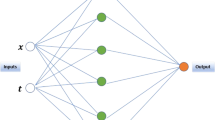Abstract
In this paper, numerical techniques are developed for solving two-dimensional Bratu equations using different neural network models optimized with the sequential quadratic programming technique. The original two-dimensional problem is transformed into an equivalent singular, nonlinear boundary value problem of ordinary differential equations. Three neural network models are developed for the transformed problem based on unsupervised error using log-sigmoid, radial basis and tan-sigmoid functions. Optimal weights for each model are trained with the help of the sequential quadratic programming algorithm. Three test cases of the equation are solved using the proposed schemes. Statistical analysis based on a large number of independent runs is carried out to validate the models in terms of accuracy, convergence and computational complexity.









Similar content being viewed by others
References
Khan JA, Raja MAZ, Qureshi IM (2011) Stochastic computational approach for complex nonlinear ordinary differential equations. Chin Phys Lett 28(2):020206
Meada AJ, Fernandez AA (1994) The numerical solution of linear ordinary differential equation by feed forward neural network. Math Comput Model 19:1–25
Yazdi HS, Pourreza R (2010) Unsupervised adaptive neural-fuzzy inference system for solving differential equations. Appl Soft Comput 10.1:267–275
Shirvany Y, Hayati M, Moradian R (2009) Multilayer perceptron neural networks with novel unsupervised training method for numerical solution of the partial differential equations. Appl Soft Comput 9:20–29
Khan JA, Raja MAZ, Qureshi IM (2011) Novel approach for van der Pol Oscillator on the continuous time domain. Chin Phys Lett 28:110205. doi:10.1088/0256-307X/28/11/110205
Khan JA, Raja MAZ, Qureshi IM (2011) Hybrid evolutionary computational approach: application to van der Pol oscillator. Int J Phys Sci 6(31):7247–7261
Effati, S, Pakdaman M (2012) Optimal control problem via neural networks. Neural Comput Appl pp 1–8
Raja MAZ, Samar R (2014) Numerical Treatment for nonlinear MHD Jeffery-Hamel problem using Neural Networks Optimized with Interior Point Algorithm. Neurocomputing 124:178–193. doi:10.1016/j.neucom.2013.07.013
Raja MAZ, Samar R (2014) Numerical treatment of nonlinear MHD Jeffery-Hamel problems using stochastic algorithms. Comput Fluids 91:28–46
Monterola C, Saloma C (2001) Solving the nonlinear Schrodinger equation with an unsupervised neural network. Opt Exp 9(2):72–84
Raja MAZ, Khan JA, Qureshi IM (2013) Numerical treatment for Painlevé Equation I using neural networks and stochastic solvers. Innov Intell Mach 3. Springer, Berlin, pp103–117
Raja MAZ, Khan JA, Ahmad SI, Qureshi IM (2012) Solution of the Painlevé Equation-I using neural network optimized with swarm intelligence. Comput Intell Neurosci ID 721867 Vol. 2012, p 10
Raja MAZ (2014) Unsupervised neural networks for solving Troesch’s problem. Chin Phys B 23(1):018903
Raja MAZ Stochastic numerical techniques for solving Troesh’s problem. Accepted in Information Sciences. doi:10.1016/j.ins.2014.04.036
Raja MAZ, Ahmad SI (2014) Numerical treatment for solving one-dimensional Bratu Problem using Neural networks. Neural Comput Appl 24(3–4):549–561. doi:10.1007/s00521-012-1261-2
Raja MAZ Solution of one-dimension Bratu equation arising in fuel ignition model using ANN optimized with PSO and SQP, Accepted in Connection Science, 17-04-14. doi:10.1080/09540091.2014.907555
Khan JA, Raja MAZ, Qureshi IM (2011) Numerical treatment of nonlinear Emden-Fowler equation using stochastic technique. Ann Math Artif Intell 63(2):185–207
Raja MAZ, Khan JA, Qureshi IM (2010) Evolutionary computational intelligence in solving the fractional differential equations. In: Intelligent Information and Database Systems. Springer Berlin Heidelberg, pp 231–240
Raja MAZ, Khan JA, Qureshi IM (2011) Swarm Intelligent optimized neural networks for solving fractional differential equations. Int J Innov Comput Inf Control 7(11):6301–6318
Raja MAZ, Khan JA, Qureshi IM (2010) A new stochastic approach for solution of Riccati differential equation of fractional order. Ann Math Artif Intell 60(3–4):229–250
Raja MAZ, Khan JA, Qureshi IM (2011) Solution of fractional order system of Bagley-Torvik equation using evolutionary computational intelligence. Math Prob Eng, vol. 2011, Article ID. 675075, p 18
Raja MAZ, Ahmad SI, Samar R (2012) Neural network optimized with evolutionary computing technique for solving the 2-dimensional Bratu problem. Neural Comput Appl. doi:10.1007/s00521-012-1170-4
MAZ Raja, Ahmad SI, Samar R Solution of the 2-Dimensional Bratu Problem using neural network, Swarm Intelligence and Sequential Quadratic Programming, Neural Comput Appl, submitted on 06-03-2013
Curtis FE, Overton ML (2012) A sequential quadratic programming algorithm for nonconvex, nonsmooth constrained optimization. SIAM J Optim 22(2):474–500
Gill PE, Wong E (2012) Sequential quadratic programming methods. In: Mixed integer nonlinear programming. Springer New York, pp 147–224
Nocedal J, Wright SJ (2006) Numerical optimization, Springer series in operations research, 2nd edn. Springer, Berlin
Sivasubramani S, Swarup KS (2011) Sequential quadratic programming based differential evolution algorithm for optimal power flow problem. IET Gener Transm Distrib 5(11):1149–1154
Aleem SHEA, Zobaa AF, Abdel Aziz MM (2012) Optimal C-type passive filter based on minimization of the voltage harmonic distortion for nonlinear loads. IEEE Trans Indu Electron 59(1):281–289
Jiejin C, Qiong L, Lixiang L, Haipeng P, Yixian Y (2012) A hybrid FCASO-SQP method for solving the economic dispatch problems with valve-point effects. Energy 38(1):346–353
Yu MT, Lin TY, Hung C (2012) Sequential quadratic programming method with a global search strategy on the cutting-stock problem with rotatable polygons. J Intell Manuf 23(3):787–795
Izmailov AF, Pogosyan AL A semismooth sequential quadratic programming method for lifted mathematical programs with vanishing constraints. Comput Math Math Phys 51.6 (2011): 919–941
Tang C, et al (2013) A feasible SQP-GS algorithm for nonconvex, nonsmooth constrained optimization. Numer Algorithms (2013): 1–22
Syam MI, Hamdan A (2006) An efficient method for solving Bratu equations. Appl Math Comput 176:704–713
Muhammed Syam I (2007) The modified Broyden-variational method for solving nonlinear elliptic differential equations. Chaos Solitons Fract 32:392–404
Gidas B, Ni W, Nirenberg L (1979) Symmetry and related properties via the maximum principle. Comm Math Phys 68:209–243
Bratu G (1914) Sur les équations intégrales non linéaires. Bull Soc Math France 43:113–142
Gelfand IM (1963) Some problems in the theory of quasi-linear equations. Trans Am Math Soc Ser 2:295–381
Jacobsen J, Schmitt K (2002) The Liouville-Bratu-Gelfand problem for radial operators. J Diff Eq 184:283–298
Buckmire R (2003) On exact and numerical solutions of the one-dimensional planar Bratu problem, 2003. http://faculty.oxy.edu/ron/research/bratu/bratu.pdf
Frank-Kamenetski DA (1955) Diffusion and heat exchange in chemical kinetics. Princeton University Press, Princeton
Wan YQ, Guo Q, Pan N (2004) Thermo-electro-hydrodynamic model for electrospinning process. Int J Nonlinear Sci Numer Simul 5(1):5–8
Beidokhti RS, Malek A (2009) Solving initial-boundary value problems for systems of partial differential equations using neural networks and optimization techniques. J Franklin Inst 346(9):898–913
Parisi DR, Mariani MC, Laborde MA (2003) Solving differential equations with unsupervised neural networks. Chem Eng Process 42(8–9):715–721
Author information
Authors and Affiliations
Corresponding author
Appendix
Appendix
The derived solutions by each neural networks model in case of all three BVPs of Bratu-type equations are given in Tables 8, 9 and 10, respectively. The solutions are presented with 14 decimal points for the unknown weights to exactly reproduce the results presented in the body of manuscript and to avoid rounding of error problem.
Rights and permissions
About this article
Cite this article
Raja, M.A.Z., Samar, R. & Rashidi, M.M. Application of three unsupervised neural network models to singular nonlinear BVP of transformed 2D Bratu equation. Neural Comput & Applic 25, 1585–1601 (2014). https://doi.org/10.1007/s00521-014-1641-x
Received:
Accepted:
Published:
Issue Date:
DOI: https://doi.org/10.1007/s00521-014-1641-x




